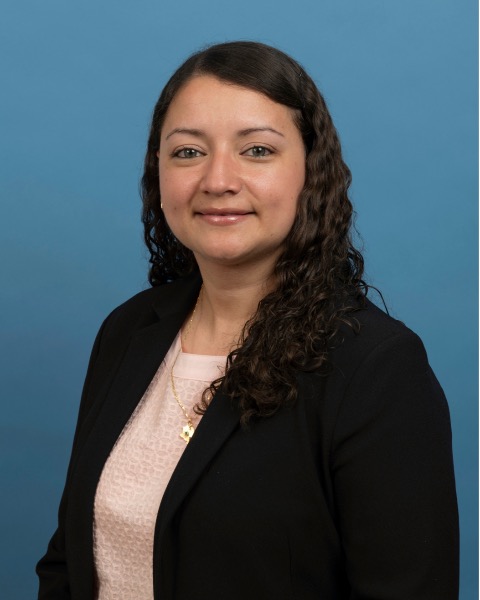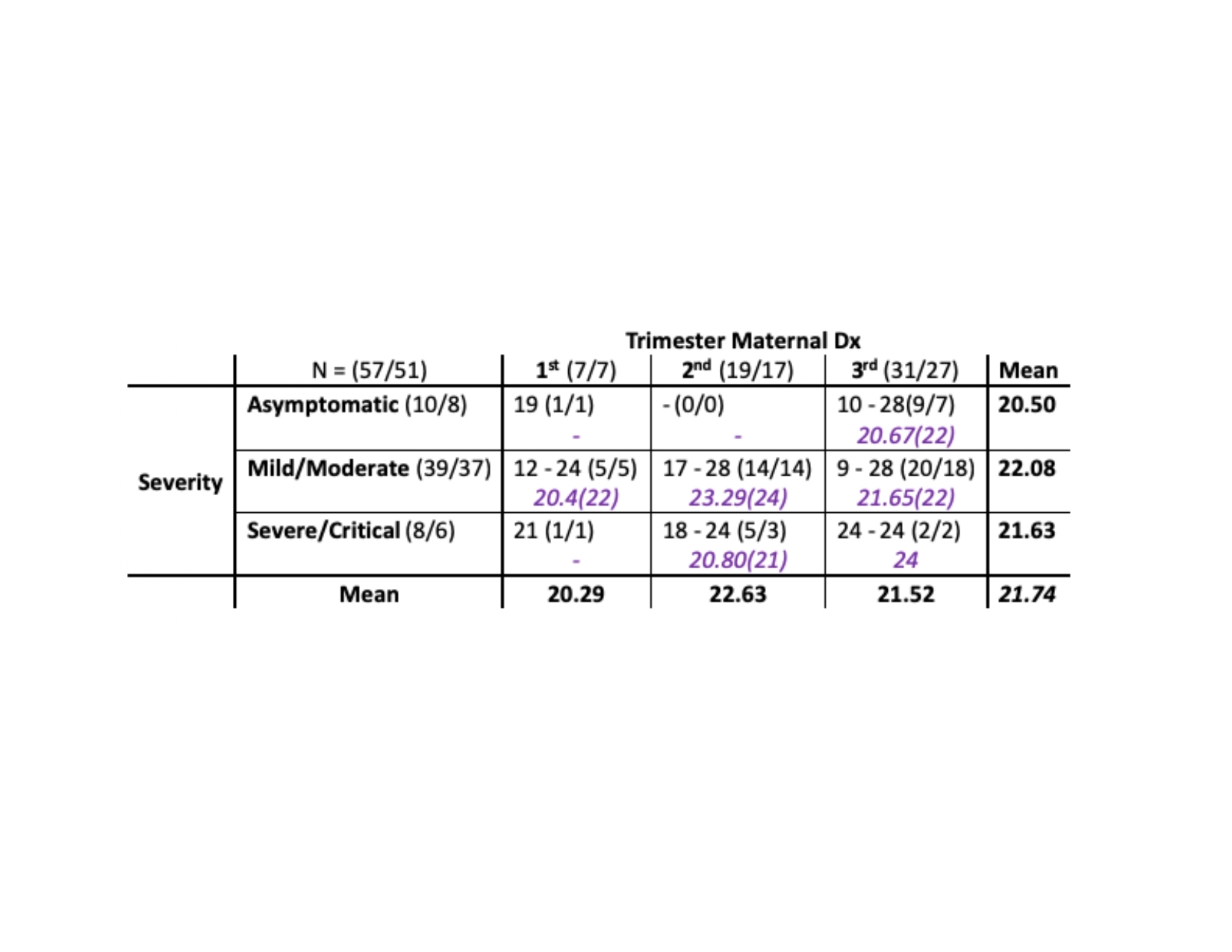Neonatal Follow-up
Category: Abstract Submission
Neonatal Follow-up II
255 - Neuromotor function in infants exposed to Prenatal SARS-CoV-2 infection using the General Movement Assessment Tool
Saturday, April 23, 2022
3:30 PM - 6:00 PM US MT
Poster Number: 255
Publication Number: 255.224
Publication Number: 255.224
VIVIANA M. FAJARDO, University of California, Los Angeles David Geffen School of Medicine, Los Angeles, CA, United States; Dajie Zhang, KJP, Goettingen, Niedersachsen, Germany; Mary C. Cambou, UCLA Mattel Childrens Hospital, Los Ángeles, CA, United States; Thalia Mok, University of California, Los Angeles David Geffen School of Medicine, Los Angeles, CA, United States; Sophia G. Paiola, University of California, Los Angeles, Torrance, CA, United States; Debika Bhattacharya, UCLA, Los Angeles, CA, United States; Rashmi Rao, University of California, Los Angeles David Geffen School of Medicine, Los Angeles, CA, United States; Tara Kerin, University of California, Los Angeles David Geffen School of Medicine, Los Angeles, CA, United States; Trevon L. Fuller, University of California, Los Angeles David Geffen School of Medicine, Los Angeles, CA, United States; Fatima M. Ferreira, Universidade Federal do estado do rio de janeiro, Rio de Janeiro, Rio de Janeiro, Brazil; Patricia Brasil, AFI Clinic at Fundacao Oswaldo Cruz (FIOCRUZ), Rio de Janeiro, Rio de Janeiro, Brazil; Christa Einspieler, Medical University of Graz, Graz, Steiermark, Austria; Peter B. Marschik, University Medical Center Göttingen, Göttingen, Niedersachsen, Germany; Karin Nielsen-Saines, University of California, Los Angeles David Geffen School of Medicine, Los Angeles, CA, United States

VIVIANA FAJARDO, MD
Assistant Clinical Professor
UCLA Mattel Childrens Hospital
Los Angeles, California, United States
Presenting Author(s)
Background: The massive outbreak of newly emerged coronavirus disease 2019 (COVID19) saw rapid global spread, leading to a pandemic infection and an unprecedented global health emergency. Cumulative studies have shown an association between prenatal exposure of acute respiratory virus infections such as Coronaviruses and Influenza and an increased risk of neurodevelopmental disorders in offspring, such as cerebral palsy, autism spectrum disorder and schizophrenia. There is an urgent need to assess neurodevelopment in prenatally exposed SARS-CoV-2 infants. General Movements Assessment (GMA) is a screening tool for detection of neurological impairments such as cerebral palsy at an early age.
Objective: To perform GMA at 9-20 weeks post-term age in infants exposed to COVID19 infection in utero.
Design/Methods: This is an observational longitudinal cohort study where infants prenatally exposed to SARS-CoV-2 during any trimester in pregnancy were recruited at a single tertiary care center in Los Angeles, California between March 2020 to present. We evaluated general movements of 57 infants by video recordings, lasting 2-3 minutes, of active wakefulness lying in supine position without manipulation.
Results: Motor Optimality Scores (MOS) were generated based on age-specific movement repertoire, postural patterns, and movement character for each infant. Reported median of MOS for typically developing infants is 26. Of the 57 infants, MOS ranged from 9 to 28, with median 23, and IQR 21-24. Five infants scored between 9 and 13 points, 4 between 17 and 19 points, 40 between 20 and 24, and 8 infants between 25 and 28. 16 infants were born before 37 weeks of gestational age, including 4 multiple-births with 10 infants. These 16 infants scored a median of 22 and IQR 21-24. The 41 term-born infants scored a median of 23 and IQR 21-24. The lower median score obtained for this group of infants could be due in part to recording technicalities. Nevertheless, the slightly lower median score potentially reflects heightened stress caused by infection during pregnancy, although the deviance may be transient and the infants could have normal outcomes. An average MOS of 20 points or higher is seen as non-pathological and this was the case in most infants within the cohort. However, 15.8% of babies had scores lower than 20 and should be closely followed.Conclusion(s): Most infants prenatally exposed to SARS-CoV-2 infection are likely not affected in their neuro-motor functions. Nevertheless, it is critical for these infants to have long-term follow up to identify potential outliers who would benefit from early directed intervention.
Motor Optimality Scores (MOS) of 57 infants grouped by maternal Covid-19 symptom Severity and Trimester of maternal infection. Numbers indicate the range of MOS in the cell. Italic formatted number indicate the cell mean(median).
Numbers indicate the range of MOS in the cell. Italic formatted number indicate the cell mean(median).
Key: (x/y) - x = number of infants; y = number of mothers
Objective: To perform GMA at 9-20 weeks post-term age in infants exposed to COVID19 infection in utero.
Design/Methods: This is an observational longitudinal cohort study where infants prenatally exposed to SARS-CoV-2 during any trimester in pregnancy were recruited at a single tertiary care center in Los Angeles, California between March 2020 to present. We evaluated general movements of 57 infants by video recordings, lasting 2-3 minutes, of active wakefulness lying in supine position without manipulation.
Results: Motor Optimality Scores (MOS) were generated based on age-specific movement repertoire, postural patterns, and movement character for each infant. Reported median of MOS for typically developing infants is 26. Of the 57 infants, MOS ranged from 9 to 28, with median 23, and IQR 21-24. Five infants scored between 9 and 13 points, 4 between 17 and 19 points, 40 between 20 and 24, and 8 infants between 25 and 28. 16 infants were born before 37 weeks of gestational age, including 4 multiple-births with 10 infants. These 16 infants scored a median of 22 and IQR 21-24. The 41 term-born infants scored a median of 23 and IQR 21-24. The lower median score obtained for this group of infants could be due in part to recording technicalities. Nevertheless, the slightly lower median score potentially reflects heightened stress caused by infection during pregnancy, although the deviance may be transient and the infants could have normal outcomes. An average MOS of 20 points or higher is seen as non-pathological and this was the case in most infants within the cohort. However, 15.8% of babies had scores lower than 20 and should be closely followed.Conclusion(s): Most infants prenatally exposed to SARS-CoV-2 infection are likely not affected in their neuro-motor functions. Nevertheless, it is critical for these infants to have long-term follow up to identify potential outliers who would benefit from early directed intervention.
Motor Optimality Scores (MOS) of 57 infants grouped by maternal Covid-19 symptom Severity and Trimester of maternal infection.
 Numbers indicate the range of MOS in the cell. Italic formatted number indicate the cell mean(median).
Numbers indicate the range of MOS in the cell. Italic formatted number indicate the cell mean(median). Key: (x/y) - x = number of infants; y = number of mothers
